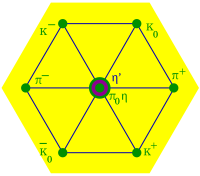Quark model

Imagine you are building a puzzle and you have a bunch of pieces that are different shapes and sizes. These pieces are like the subatomic particles that make up everything around us, like protons and neutrons that make up the nucleus of an atom.
Now, let's focus on those protons and neutrons. Scientists had figured out that these particles were made up of even smaller particles called quarks. Quarks are like the building blocks that make up protons and neutrons.
The quark model is a way of understanding how these quarks come together to make up protons and neutrons. Similar to how puzzle pieces fit together, quarks come together in groups of two or three.
There are six different types of quarks: up, down, charm, strange, top, and bottom. The up and down quarks are the lightest and most stable, and they are the ones that make up the protons and neutrons in the nucleus.
When quarks combine, they form what's called a hadron. Protons and neutrons are both considered hadrons because they are made up of quarks.
The quark model helped scientists understand how particles are made up and how they interact with each other. It's like a big puzzle where each quark has its own place and fits perfectly with the others. And just like how we can put together a puzzle to make a picture, scientists can use the quark model to understand the structures and behaviors of particles.
Now, let's focus on those protons and neutrons. Scientists had figured out that these particles were made up of even smaller particles called quarks. Quarks are like the building blocks that make up protons and neutrons.
The quark model is a way of understanding how these quarks come together to make up protons and neutrons. Similar to how puzzle pieces fit together, quarks come together in groups of two or three.
There are six different types of quarks: up, down, charm, strange, top, and bottom. The up and down quarks are the lightest and most stable, and they are the ones that make up the protons and neutrons in the nucleus.
When quarks combine, they form what's called a hadron. Protons and neutrons are both considered hadrons because they are made up of quarks.
The quark model helped scientists understand how particles are made up and how they interact with each other. It's like a big puzzle where each quark has its own place and fits perfectly with the others. And just like how we can put together a puzzle to make a picture, scientists can use the quark model to understand the structures and behaviors of particles.
Related topics others have asked about:
